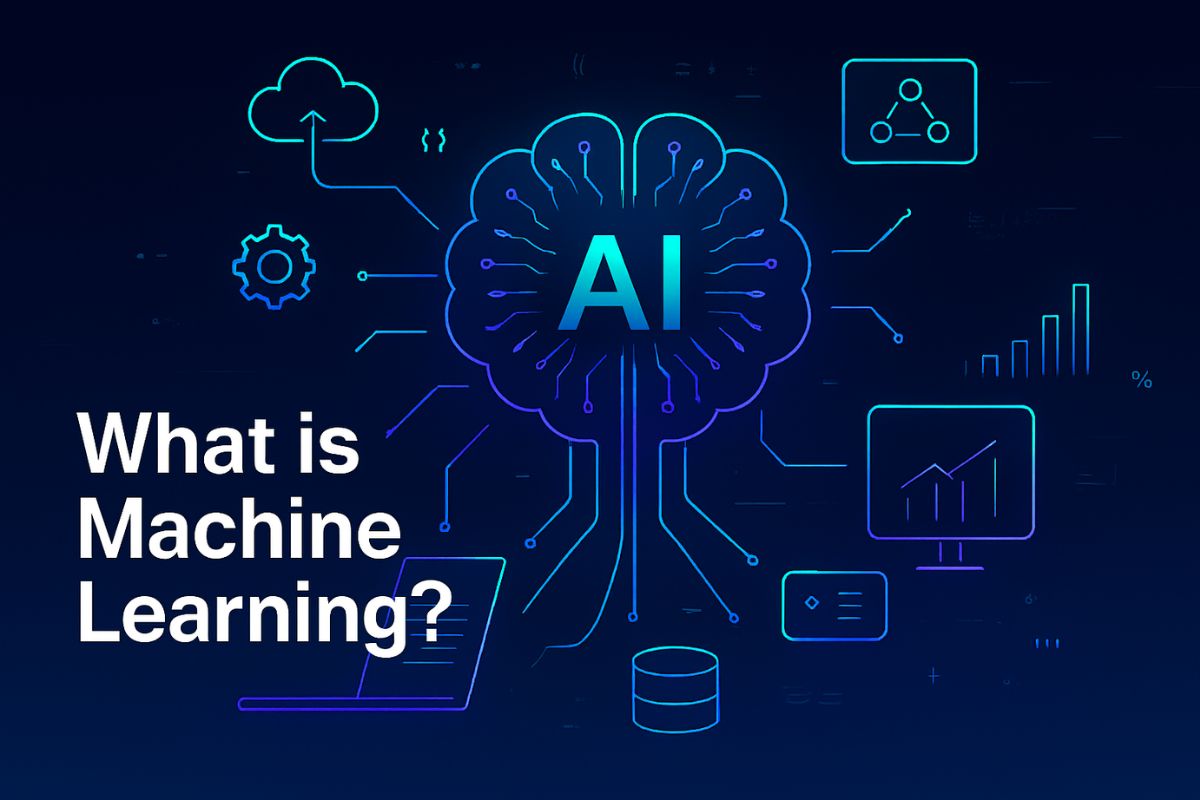Machine Learning (ML) is a powerful branch of artificial intelligence that enables computers to learn from data without being explicitly programmed. In this beginner’s guide, students in India will understand the basics of ML, its different types, real-world applications, how it compares with AI and Deep Learning, and how to start learning it from scratch. This blog also includes career opportunities, tools, mistakes to avoid, free resources, and FAQs to kickstart your ML journey.
Have you ever wondered how Netflix recommends your next favorite show, how Google Maps predicts traffic, or how YouTube suggests videos you didn’t even know you wanted to watch? The answer lies in Machine Learning (ML) — one of the most exciting and in-demand technologies shaping the world today.
For students in India, Machine Learning is not just a buzzword; it’s a gateway to future-ready careers, innovative projects, and powerful problem-solving. This beginner-friendly guide will help you understand what Machine Learning is, how it works, its applications, types, and how you can start learning it — step by step.
What is Machine Learning?
Definition in Simple Words
Machine Learning is a subset of Artificial Intelligence (AI) that allows machines to learn from data and improve their performance without being explicitly programmed.
In simple terms, ML is how computers teach themselves to do tasks by analyzing patterns and making decisions — much like how we learn from experience.
How Machine Learning Works
The basic idea behind ML is:
- Input Data
- Algorithms process data to find patterns
- Model gets trained
- Model makes predictions or decisions
- It improves over time with more data
Types of Machine Learning
Supervised Learning
In supervised learning, the model is trained on a labeled dataset. That means the input and output are both provided.
Example:
- Email Spam Classifier
- Predicting student exam scores
Unsupervised Learning
Unsupervised learning uses data that doesn’t have labeled outcomes. The model tries to find hidden patterns or groupings.
Example:
- Customer segmentation for marketing
- Grouping students based on learning behavior
Reinforcement Learning
Reinforcement learning is based on a system of rewards and punishments. The model learns by trial and error to maximize the reward.
Example:
- Game-playing AI
- Robotics and navigation
Machine Learning vs Artificial Intelligence vs Deep Learning
Simple Definitions
- Artificial Intelligence (AI): The broader concept of machines that can perform tasks like humans.
- Machine Learning (ML): A subset of AI that uses data to learn and make decisions.
- Deep Learning (DL): A subset of ML that mimics the human brain using neural networks.
Differences Table:
| Concept | Definition | Subset Of | Key Use Cases |
|---|---|---|---|
| Artificial Intelligence | Machines simulating human intelligence | Root technology | Chatbots, virtual assistants |
| Machine Learning | Learning from data without programming | AI | Recommendations, fraud detection |
| Deep Learning | ML using neural networks | ML | Image recognition, NLP, voice AI |
Real-Life Applications of Machine Learning in India
Education
- Personalized learning paths using platforms like Byju’s
- Predictive analytics to identify struggling students
Healthcare
- AI-based diagnosis systems
- Machine learning for drug discovery and patient monitoring
Agriculture
- Crop health monitoring using drone data
- Weather prediction and soil quality analysis
Finance & Banking
- Fraud detection in digital payments (Paytm, PhonePe)
- Credit scoring and loan approval automation
E-commerce
- Flipkart and Amazon use ML for product recommendations
- Chatbots and customer support automation
Table: Comparison of Machine Learning Types
| Type | Definition | Examples | Complexity |
|---|---|---|---|
| Supervised | Trained on labeled data | Spam filters, exam prediction | Moderate |
| Unsupervised | Finds patterns in unlabeled data | Customer segmentation | Medium |
| Reinforcement | Learns via rewards/punishment | Robotics, gaming AI | High |
How to Start Learning Machine Learning (Step-by-Step)
Step 1: Understand the Prerequisites
- Basic Math (Statistics, Linear Algebra)
- Python Programming
- Logical Thinking
Step 2: Choose Learning Platforms
- Free: YouTube (Krish Naik, CodeBasics, Apni Kaksha)
- Paid/Certified:
- NPTEL (by IITs)
- Google’s Machine Learning Crash Course
- Coursera (Andrew Ng’s ML course)
Step 3: Practice with Projects
- Start with small datasets (Iris, Titanic, MNIST)
- Use Kaggle for competitions
- Build your portfolio on GitHub
Tools & Languages Used in Machine Learning
| Tool / Language | Purpose | Free/Paid |
|---|---|---|
| Python | Programming Language | Free |
| Scikit-learn | ML library for Python | Free |
| TensorFlow | Deep Learning Framework | Free |
| Jupyter Notebook | IDE for experiments | Free |
| Google Colab | Cloud-based notebook platform | Free |
Career Opportunities in Machine Learning
Popular Roles
- Machine Learning Engineer
- Data Scientist
- NLP Engineer
- AI Researcher
Top Recruiters in India
- TCS, Infosys, Wipro
- Flipkart, Zomato, Swiggy
- Startups like Fractal, Innovacer
Average Salary (INR)
- Entry Level: ₹6–8 LPA
- Mid-Level: ₹12–15 LPA
- Senior Roles: ₹20+ LPA
Common Mistakes Students Make While Learning ML
- Jumping into projects without learning math
- Not practicing coding consistently
- Only watching videos — no real implementation
- Ignoring documentation and reading material
- Relying too much on ChatGPT
Bonus: Free Resources for Indian Students
- Kaggle: Datasets and competitions
- Google AI: Free ML courses and tools
- GitHub: Open-source ML projects
- NPTEL: IIT-level free certifications
- AICTE Internship Portal: ML internships in India
Conclusion
Machine Learning is revolutionizing industries — and for students, it’s a gateway to future-ready careers. Whether you’re a beginner or already familiar with AI, this guide gives you everything to take your first step in ML.
Don’t wait for the perfect moment. Start learning, stay curious, and practice consistently.
Liked this post? Share it, comment your thoughts, and explore more learning blogs on Schoolication.
FAQs
1. What is the best way to learn machine learning from scratch?
Start with Python, basic math, and take beginner courses like Andrew Ng’s on Coursera. Practice on Kaggle and build projects.
2. Is machine learning hard for beginners?
It can seem complex, but with the right guidance and consistent practice, it becomes manageable — especially for students.
3. What programming language is best for ML?
Python is the most popular and beginner-friendly language used in Machine Learning.
4. What are some real-life examples of ML in India?
ML is used in Paytm fraud detection, Flipkart recommendations, Byju’s adaptive learning, and more.
5. Can I get a job in ML without a degree?
Yes, many companies hire based on skills and projects. Certifications, portfolios, and internships help.
6. What is the difference between ML and AI?
AI is the broader concept; ML is a subset that uses data to learn and make decisions.
7. What is the salary of an ML engineer in India?
Entry-level salaries start at ₹6–8 LPA and can go beyond ₹20 LPA for experienced professionals.


